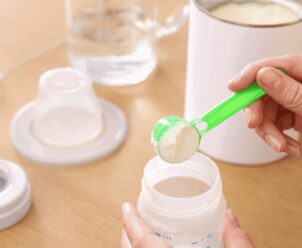

Kate Geagan, M.S., R.D.N.
Dietitian and sustainable nutrition pioneer
When it comes to feeding, every baby is different, and how often your little one wants to feed will depend on their unique needs. While it’s important to always follow your baby’s cues for feeding (not the clock or the idea of finishing every bottle) below are some helpful guidelines to keep in mind during the first days, weeks and months. As you and your baby get to know each other, you’ll likely settle into a routine. Always be sure to talk with your pediatrician about your baby’s growth and how much formula your little one needs.
Your Baby’s Age |
||
0-1 months Your newborn baby’s belly is tiny in these first days! |
Offer 1-2 fluid ounces of formula at each feeding. |
Feed on demand (not the clock), but an average of every 2-3 hours, for a total of 8-12 feedings each day. |
1-4 months Your baby’s tummy is growing, so the amounts and time between feedings will increase. |
Offer 4-6 fluid ounces of formula at each feeding. |
Most formula fed infants will feed every 3-4 hours, for a total of 5-6 feedings each day. |
4-6 months This is when healthy babies are ready to start solids, if they show signs of being developmentally ready. |
Your baby will consume 6-8 fluid ounces of formula at each feeding. |
4-5 feedings each day. The AAP recommends a maximum of 32 fluid ounces/day. |
6-9 months Even after introducing solid foods, formula remains essential nourishment for your little one during their first year of life. |
Your baby will consume 7-8 fluid ounces of formula at each feeding. |
3-4 feedings each day. Depending on the amount of solid food in your baby’s diet, your baby will consume around 24-30 fluid ounces/day. |
9-12 months As your baby starts eating more solid foods, they will gradually need less formula. |
Your baby will consume 7-8 fluid ounces of formula at each feeding. |
During this time, as intake of solid foods increases, baby’s feeding typically drops to 3 feedings and a total of around 24 fluid ounces/day. |
How do I know if my baby is getting enough formula?
Some feedings may be long and others short, as babies are very good at knowing how hungry and full they are. Let your baby set the pace, but it’s important to pay close attention for signs of hunger (lip smacking) and fullness (turning head away or becoming fidgety) to know how much your baby needs. Honoring these cues is an important process whether feeding formula from the bottle or (later) food from the highchair!
Should I wake my baby up for feedings?
If your baby sleeps longer than 4 to 5 hours during the first few weeks after birth and starts missing feedings, the American Academy of Pediatrics recommends waking your baby and offering a bottle.
What about feeding on demand?
Initially it’s best to feed your baby on demand, or whenever they cry with hunger. As time passes, most healthy babies settle into a routine and a develop a timetable of their own. Between 2 and 4 months of age (or when baby ways more than 12 lb.), most formula-fed babies no longer need a middle-of-the-night feeding. Reach out to your pediatrician if you have any questions about making this transition and what’s best for your baby.
This is for informational purposes only and should not be treated as medical advice. The content is not intended to be a substitute for professional medical advice, diagnosis, or treatment. Please always discuss any health and feeding concerns directly with your pediatrician. Never disregard professional medical advice or delay in seeking it because of something you have read above.


